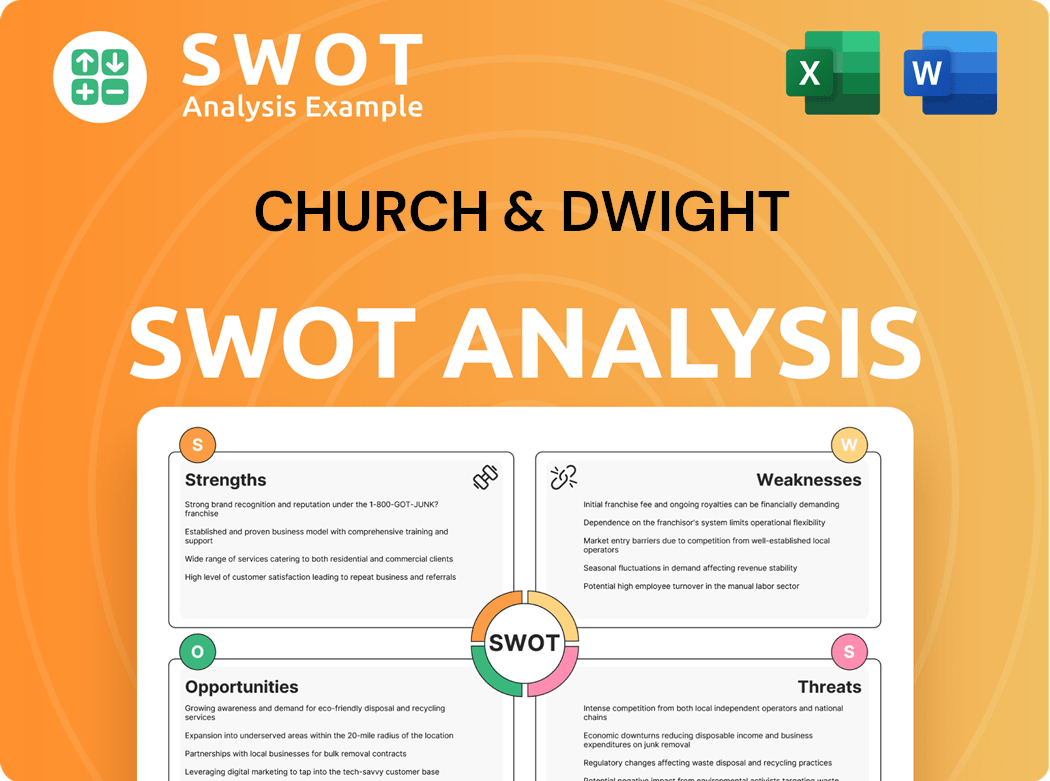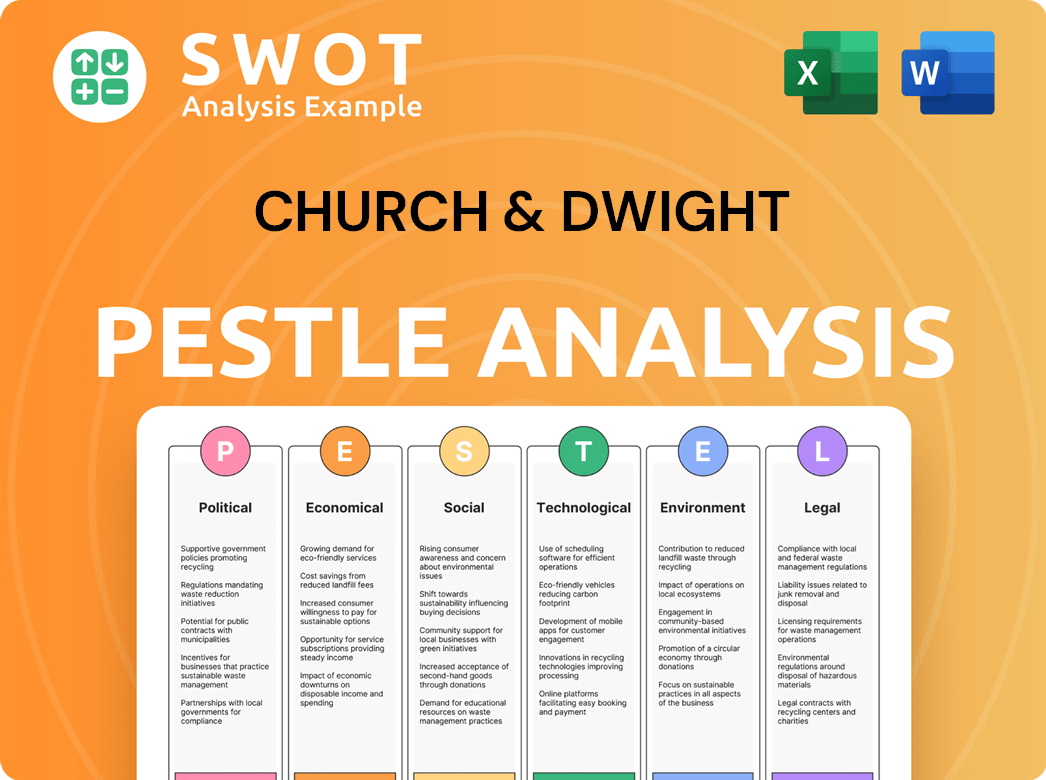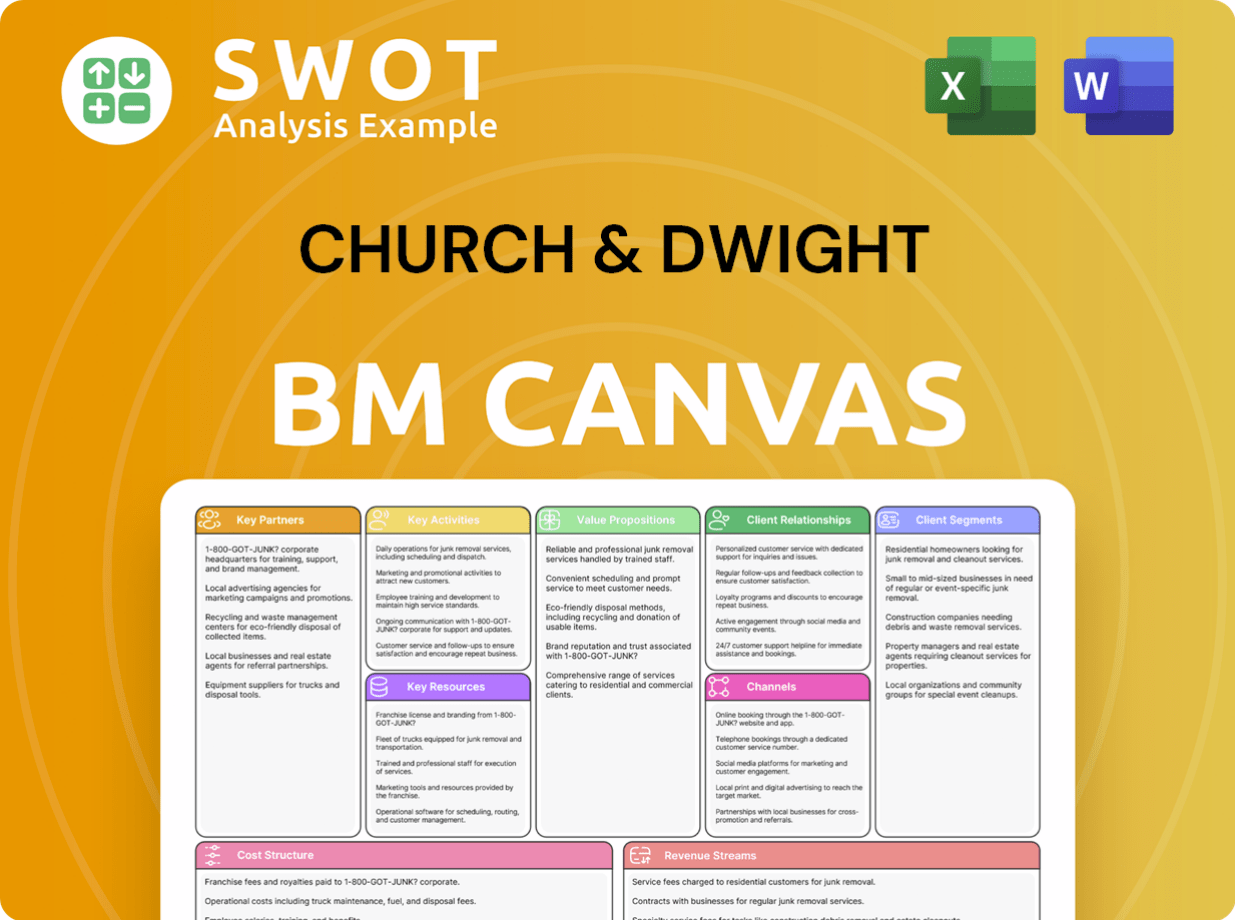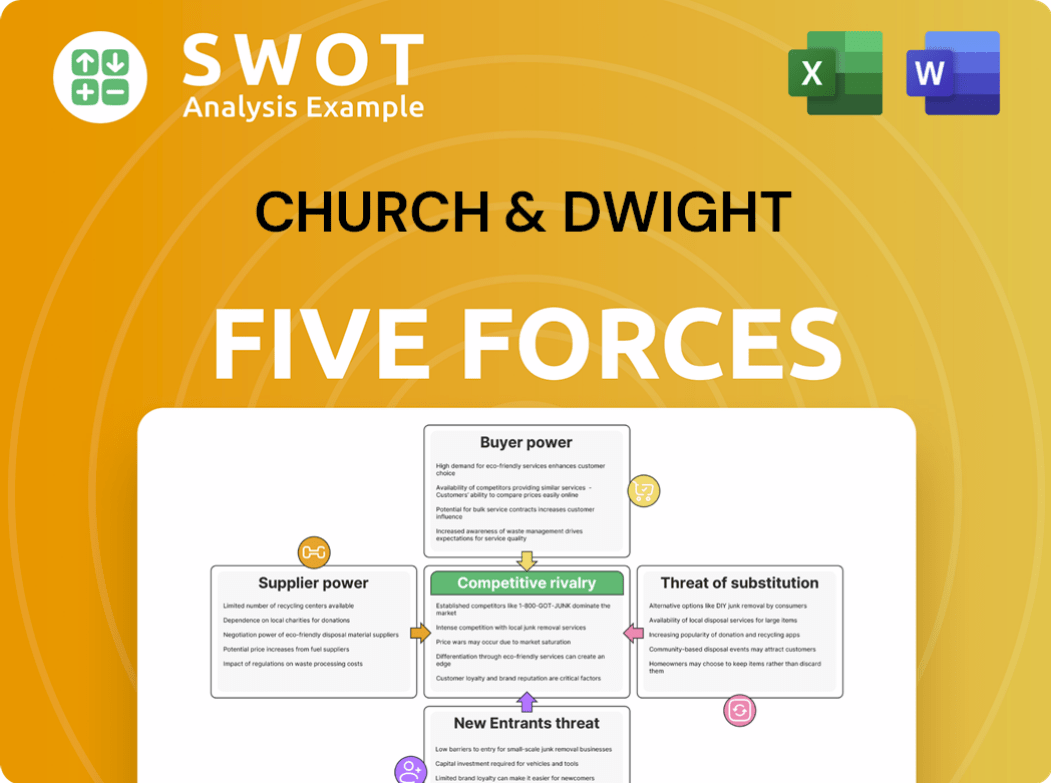Church & Dwight Bundle
Decoding Church & Dwight's Customer: Who Buys Their Products?
The health and hygiene boom, amplified by recent global events, spotlights the critical need to understand consumer behavior. For a company like Church & Dwight, navigating this landscape requires a deep dive into its customer base. Knowing the "who," "where," and "why" behind consumer choices is the cornerstone of effective business strategy.

Understanding the Church & Dwight SWOT Analysis is crucial for grasping its strategic direction. This analysis is even more critical when considering the evolution of the company's customer demographics and target market. From its humble beginnings, the company has transformed its consumer profile, expanding its brand audience through strategic acquisitions. This shift has led to intricate market segmentation and a need to continuously adapt to the evolving needs of its diverse customer base.
Who Are Church & Dwight’s Main Customers?
Understanding the Growth Strategy of Church & Dwight involves a deep dive into its customer base. The company, primarily operating in the B2C sector, has cultivated a diverse customer demographic. Its success is significantly tied to its ability to cater to a wide array of consumer needs through a varied portfolio of brands.
The customer demographics for the company are broad, with each brand targeting specific segments. Products like Arm & Hammer appeal to budget-conscious households, while Trojan targets sexually active adults. Waterpik focuses on health-conscious consumers. This strategic market segmentation allows the company to capture diverse consumer groups.
The target market for Church & Dwight is defined by the product category. For instance, Arm & Hammer's broad appeal contrasts with Trojan's more focused demographic. OxiClean targets consumers seeking effective cleaning solutions, while Waterpik caters to those prioritizing oral health. Analyzing these segments offers insights into the company's revenue streams and growth potential.
The Arm & Hammer brand typically attracts middle-income households. The customer demographics span a wide age range, focusing on value and efficacy in cleaning and deodorizing. This segment is characterized by a focus on affordability and practical solutions for household needs.
Trojan targets sexually active adults, with a demographic skew towards younger adults. This segment prioritizes sexual health and wellness. Purchasing behaviors differ significantly from household cleaning consumers, focusing on personal health and safety.
OxiClean's brand audience includes consumers seeking powerful cleaning solutions. This segment is often willing to pay a premium for effective stain removal and laundry additives. The demographic includes a broad age range, with a focus on household maintenance.
Waterpik attracts consumers of all ages interested in preventative care and advanced hygiene. This segment often has higher disposable incomes and a greater awareness of health trends. The focus is on preventative oral health solutions.
The company's strategic acquisitions and product innovations have consistently reshaped its market segmentation. For example, the acquisition of Waterpik expanded its reach into the health and wellness sector. Sustained investment in brands like OxiClean has allowed it to capture consumers seeking powerful cleaning solutions. These shifts are driven by market research and evolving consumer trends. In 2024, the company reported net sales of approximately $6.2 billion, with a significant portion attributed to its consumer domestic segment, highlighting the strength of its B2C focus. As of early 2024, the company's diverse product portfolio continues to serve a wide range of consumer needs, reflecting its adaptive customer demographics and target market strategies.
Church & Dwight's success is built on understanding and catering to diverse consumer segments. The customer demographics vary significantly across its brand portfolio, from budget-conscious families to health-conscious individuals. This strategic approach allows the company to maintain a strong market position and drive growth.
- Arm & Hammer targets budget-conscious households.
- Trojan focuses on sexually active adults.
- OxiClean appeals to consumers seeking powerful cleaning solutions.
- Waterpik attracts health-conscious consumers.
Church & Dwight SWOT Analysis
- Complete SWOT Breakdown
- Fully Customizable
- Editable in Excel & Word
- Professional Formatting
- Investor-Ready Format

What Do Church & Dwight’s Customers Want?
Understanding the customer needs and preferences is critical for the success of any business. This is especially true for a company like Church & Dwight, which has a diverse portfolio of products catering to a wide range of consumer needs. Analyzing the customer demographics and target market allows for effective marketing strategies and product development.
The company's approach involves understanding the motivations behind purchasing decisions across different product categories. This includes factors like effectiveness, value, and brand reputation. By tailoring its strategies to meet these varied needs, Church & Dwight aims to maintain and grow its customer base.
The customer base of Church & Dwight is broad, encompassing various demographics and psychographics. The company’s products are designed to address a variety of consumer needs, from household cleaning to personal care and oral health. This diversity requires a nuanced understanding of each segment to effectively target and serve them.
For household staples like Arm & Hammer baking soda and laundry detergents, customers prioritize effectiveness, value, and reliability. Purchasing behavior is often driven by routine replenishment and a desire for trusted solutions for everyday cleaning and deodorizing. Decision-making criteria include price point, brand reputation, and perceived efficacy.
Consumers of Trojan products are primarily motivated by sexual health, safety, and pleasure. Purchasing decisions are highly personal and often influenced by discretion, trust in the brand, and product variety. Loyalty factors in this segment can be tied to consistent quality and a brand's commitment to sexual wellness education.
For oral care products like Waterpik, customers seek preventative health benefits, convenience, and often, professional-grade results at home. Motivations are rooted in maintaining good oral hygiene and addressing specific dental concerns. The focus is on health and wellness.
Products like OxiClean address pain points such as tough stains, while Nair targets hair removal needs. These products are designed to provide effective solutions to common consumer problems. The focus is on convenience and performance.
Customer feedback and market trends play a crucial role in product development. For example, the increasing consumer demand for natural and environmentally friendly products has likely influenced the development of eco-friendly variants within their cleaning lines. The company adapts to consumer preferences.
The company tailors its marketing by highlighting specific benefits relevant to each segment, such as 'deep cleaning' for OxiClean or 'superior oral hygiene' for Waterpik. Promotional strategies often emphasize value for household goods, while personal care products may focus on lifestyle and wellness. The approach is segmented.
Understanding the customer demographics and target market is vital for Church & Dwight to maintain its competitive edge. This involves analyzing consumer profiles and adjusting strategies based on market segmentation. The company's success depends on its ability to meet diverse consumer needs.
- Customer Demographics: Analyzing age range, income levels, geographic location, and lifestyle to understand the core customer base.
- Market Segmentation: Dividing the market into distinct groups based on needs, behaviors, and preferences to tailor marketing efforts.
- Brand Audience: Identifying the specific groups that are most likely to purchase certain products, such as the target audience for Nair hair removal.
- Product Purchasing Patterns: Examining how often customers buy products, what influences their choices, and how they use the products.
- Brand Loyalty Factors: Understanding what keeps customers coming back, such as consistent quality or brand trust.
- Psychographics of Consumers: Exploring the values, attitudes, and lifestyles of consumers to create more effective marketing campaigns.
For a deeper dive into how the company operates, consider reading about the Revenue Streams & Business Model of Church & Dwight.
Church & Dwight PESTLE Analysis
- Covers All 6 PESTLE Categories
- No Research Needed – Save Hours of Work
- Built by Experts, Trusted by Consultants
- Instant Download, Ready to Use
- 100% Editable, Fully Customizable

Where does Church & Dwight operate?
The geographical market presence of Church & Dwight is primarily segmented into Consumer Domestic, Consumer International, and Specialty Products. The United States serves as the company's most significant market, where it has established a strong market share and brand recognition across its diverse portfolio of household and personal care brands. This is reflected in the performance of its Consumer Domestic segment, which reported net sales of approximately $4.2 billion in 2023.
Beyond the U.S., Church & Dwight is actively expanding its Consumer International segment, focusing on regions that offer growth opportunities. While specific country-by-country market share details are not publicly available, international expansion remains a strategic priority. The company carefully considers variations in customer demographics, preferences, and purchasing power across these regions, adapting strategies accordingly. For example, product formulations, packaging, and marketing messages are often localized to align with cultural nuances and regulatory requirements.
The company's approach includes adjusting pricing strategies to reflect local economic conditions and competitive landscapes. Expansion often involves acquiring international brands or organically growing existing ones into new territories. Conversely, strategic withdrawals may occur in markets where performance falls short of expectations or where the competitive environment is overly challenging. The geographic distribution of sales indicates a strong reliance on the North American market, but with increasing efforts to diversify and expand its global footprint, especially in emerging markets where consumer demand for household and personal care products is rising.
Church & Dwight employs market segmentation to target specific customer demographics and tailor its product offerings. This includes segmenting consumers based on age, income, lifestyle, and geographic location. Understanding the consumer profile allows for more effective marketing campaigns and product development strategies.
The company's geographic focus is primarily in North America, with a significant presence in the United States. However, it is also expanding its reach into international markets. This expansion is driven by the need to diversify revenue streams and capitalize on growth opportunities in emerging markets.
Church & Dwight adapts its products and marketing messages to suit the specific needs and preferences of different regions. This can involve modifying product formulations, packaging, and advertising campaigns. The company also adjusts its pricing strategies to reflect local economic conditions and competitive landscapes.
The company aims to maintain and grow its market share in both domestic and international markets. This involves strategic acquisitions, organic growth, and innovative product development. The company's ability to understand and respond to changing customer demographics is crucial for its continued success.
Understanding the brand audience is key to tailoring marketing efforts and product development. This involves analyzing customer demographics, psychographics, and purchasing behaviors. The company's diverse portfolio of brands caters to a wide range of consumer needs and preferences.
The competitive landscape influences Church & Dwight's geographical strategy. The company faces competition from both domestic and international brands. For a deeper understanding of the competitive environment, consider exploring the Competitors Landscape of Church & Dwight.
Church & Dwight Business Model Canvas
- Complete 9-Block Business Model Canvas
- Effortlessly Communicate Your Business Strategy
- Investor-Ready BMC Format
- 100% Editable and Customizable
- Clear and Structured Layout

How Does Church & Dwight Win & Keep Customers?
To acquire and retain customers, the company utilizes a multi-channel strategy. This approach blends traditional advertising with digital marketing, sales tactics, and product innovation. For example, mass-market advertising is used for brands like Arm & Hammer and OxiClean, leveraging television, print, and digital platforms. Social media campaigns and influencer marketing are also key.
Retention strategies focus on building brand loyalty through consistent product quality, innovation, and value. The continuous introduction of new products or improved formulations aims to keep existing customers engaged. Loyalty programs, often integrated through retailers, offer discounts or exclusive access to new products. Data analytics and CRM systems help tailor marketing messages based on past purchase behavior.
Customer data is crucial for segmenting audiences and understanding customer lifetime value. Successful acquisition campaigns often highlight product efficacy, while retention initiatives emphasize brand trust. The company has increased its digital presence and e-commerce capabilities, recognizing the growing importance of online sales channels. This shift impacts customer loyalty by making products more accessible, potentially increasing lifetime value through direct consumer engagement.
The company uses television, print, and digital platforms for brands like Arm & Hammer and OxiClean. This broad approach aims to reach a wide audience. These campaigns often focus on product benefits and value.
Social media campaigns and influencer marketing are used to target specific demographic segments. This includes brands like Trojan and Waterpik. Targeted digital ads help reach specific consumer profiles.
Sales promotions, coupons, and in-store displays are utilized to drive initial purchases. These tactics encourage trial and repeat buying. They are crucial for boosting short-term sales.
Continuous innovation, like new scents or improved formulations, keeps existing customers engaged. The company focuses on providing value and meeting evolving consumer needs. This is a key part of their retention strategy.
The company focuses on reaching specific demographics through targeted advertising campaigns. This includes using data analytics to understand consumer behavior. This approach helps in optimizing marketing spend.
Increasing the digital presence and e-commerce capabilities is a key focus. This allows for direct consumer engagement and potential subscription models. This strategy enhances customer loyalty.
The company uses customer data to segment audiences and optimize marketing campaigns. This includes understanding customer lifetime value and personalizing marketing messages. This approach improves campaign effectiveness.
Loyalty programs, often integrated through retailers, offer discounts and exclusive access. These programs are designed to build brand loyalty and encourage repeat purchases. This strategy is crucial for customer retention.
The company emphasizes consistent product quality and value to build trust. This includes offering effective products at competitive prices. These factors are key to customer satisfaction.
Understanding consumer behavior is critical for effective marketing. This involves analyzing purchasing patterns and preferences. This analysis informs product development and marketing strategies.
The company's customer acquisition and retention strategies are multifaceted, using both traditional and digital channels. These strategies are designed to build brand loyalty and drive sales. For more insights, you can explore the Growth Strategy of Church & Dwight.
- Mass-market advertising for broad reach.
- Targeted digital campaigns for specific demographics.
- Product innovation to keep customers engaged.
- Data-driven marketing to personalize experiences.
- Loyalty programs to reward repeat purchases.
Church & Dwight Porter's Five Forces Analysis
- Covers All 5 Competitive Forces in Detail
- Structured for Consultants, Students, and Founders
- 100% Editable in Microsoft Word & Excel
- Instant Digital Download – Use Immediately
- Compatible with Mac & PC – Fully Unlocked

Related Blogs
- What are Mission Vision & Core Values of Church & Dwight Company?
- What is Competitive Landscape of Church & Dwight Company?
- What is Growth Strategy and Future Prospects of Church & Dwight Company?
- How Does Church & Dwight Company Work?
- What is Sales and Marketing Strategy of Church & Dwight Company?
- What is Brief History of Church & Dwight Company?
- Who Owns Church & Dwight Company?
Disclaimer
All information, articles, and product details provided on this website are for general informational and educational purposes only. We do not claim any ownership over, nor do we intend to infringe upon, any trademarks, copyrights, logos, brand names, or other intellectual property mentioned or depicted on this site. Such intellectual property remains the property of its respective owners, and any references here are made solely for identification or informational purposes, without implying any affiliation, endorsement, or partnership.
We make no representations or warranties, express or implied, regarding the accuracy, completeness, or suitability of any content or products presented. Nothing on this website should be construed as legal, tax, investment, financial, medical, or other professional advice. In addition, no part of this site—including articles or product references—constitutes a solicitation, recommendation, endorsement, advertisement, or offer to buy or sell any securities, franchises, or other financial instruments, particularly in jurisdictions where such activity would be unlawful.
All content is of a general nature and may not address the specific circumstances of any individual or entity. It is not a substitute for professional advice or services. Any actions you take based on the information provided here are strictly at your own risk. You accept full responsibility for any decisions or outcomes arising from your use of this website and agree to release us from any liability in connection with your use of, or reliance upon, the content or products found herein.